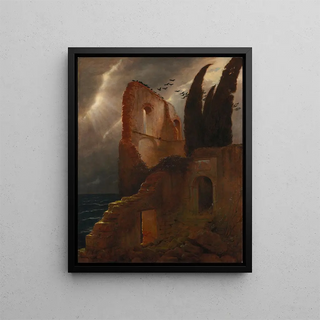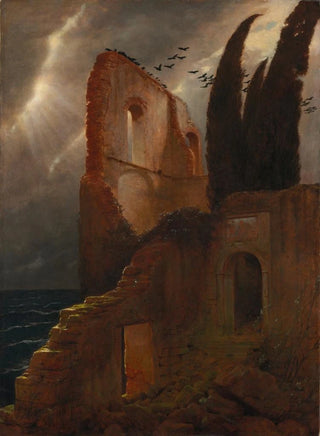Painting Ruin by the Sea - Arnold Böcklin | Art print


View from behind

Frame (optional)
In the fascinating world of art, some works manage to capture the collective imagination, transcending time and space. "Ruine au bord de la mer" by Arnold Böcklin is a perfect example. This canvas, which evokes a landscape that is both melancholic and mysterious, transports the viewer to a world where nature and human remnants intertwine harmoniously. The scene, bathed in soft, golden light, invites contemplation and reflection on the passage of time and the fragility of existence. Through this piece, Böcklin offers us a visual journey that evokes deep emotions and a connection with the sublime.
Style and uniqueness of the work
Arnold Böcklin's style is distinguished by his symbolist approach, blending realism and fantastical elements. In "Ruine au bord de la mer," the artist uses rich colors and organic shapes to create an atmosphere that is both serene and unsettling. The ruin, with its majestic columns and stones worn by time, suggests a forgotten story, while the sea, calm and vast, symbolizes infinity and eternity. This duality between decadence and beauty is at the heart of the artwork, offering a reflection on the ephemeral nature of life. The meticulously painted details, such as the reflections of light on the water and the lush vegetation, testify to Böcklin's talent for capturing the nuances of nature. This painting, with its enchanting aesthetic, thus becomes a window into a world where dream and reality blend.
The artist and his influence
Arnold Böcklin, born in 1827 in Switzerland, is one of the major figures of European symbolism and romanticism. His work, rich in mythological and poetic references, has influenced many contemporary and later artists. Böcklin was able to incorporate elements of ancient mythology into his creations, making him a pioneer in exploring themes of death, nature, and the unconscious. "Ruine au bord de la mer" perfectly illustrates this

Matte finish

View from behind

Frame (optional)
In the fascinating world of art, some works manage to capture the collective imagination, transcending time and space. "Ruine au bord de la mer" by Arnold Böcklin is a perfect example. This canvas, which evokes a landscape that is both melancholic and mysterious, transports the viewer to a world where nature and human remnants intertwine harmoniously. The scene, bathed in soft, golden light, invites contemplation and reflection on the passage of time and the fragility of existence. Through this piece, Böcklin offers us a visual journey that evokes deep emotions and a connection with the sublime.
Style and uniqueness of the work
Arnold Böcklin's style is distinguished by his symbolist approach, blending realism and fantastical elements. In "Ruine au bord de la mer," the artist uses rich colors and organic shapes to create an atmosphere that is both serene and unsettling. The ruin, with its majestic columns and stones worn by time, suggests a forgotten story, while the sea, calm and vast, symbolizes infinity and eternity. This duality between decadence and beauty is at the heart of the artwork, offering a reflection on the ephemeral nature of life. The meticulously painted details, such as the reflections of light on the water and the lush vegetation, testify to Böcklin's talent for capturing the nuances of nature. This painting, with its enchanting aesthetic, thus becomes a window into a world where dream and reality blend.
The artist and his influence
Arnold Böcklin, born in 1827 in Switzerland, is one of the major figures of European symbolism and romanticism. His work, rich in mythological and poetic references, has influenced many contemporary and later artists. Böcklin was able to incorporate elements of ancient mythology into his creations, making him a pioneer in exploring themes of death, nature, and the unconscious. "Ruine au bord de la mer" perfectly illustrates this
12,34 €






